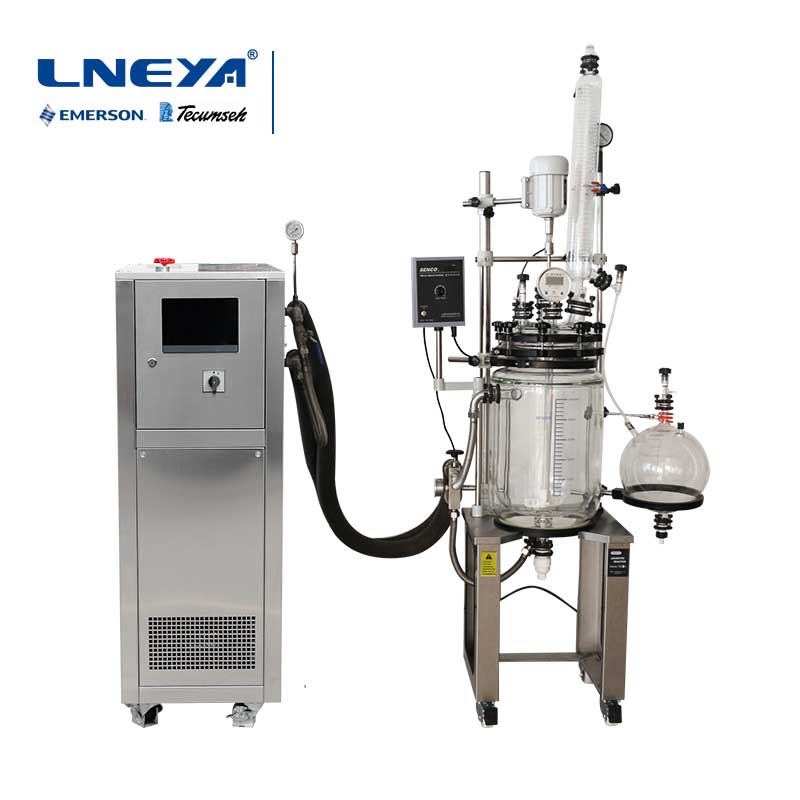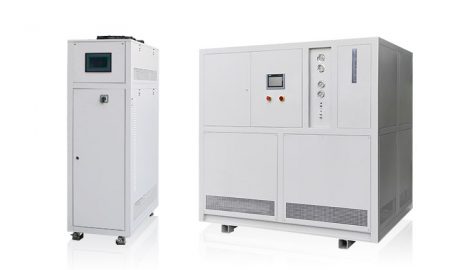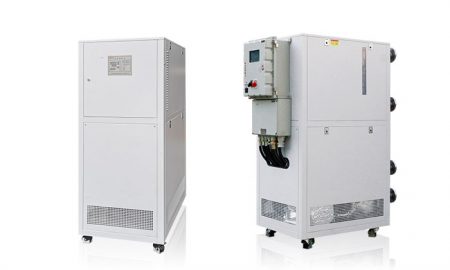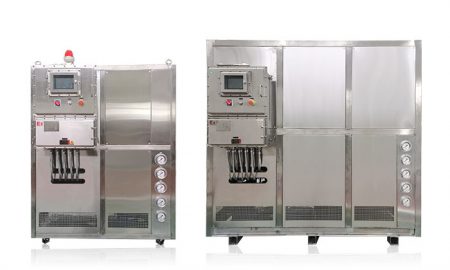Very High Temperature Reactor
Contattateci oggi stesso per la soluzione di controllo della temperatura perfetta
A very high temperature reactor is an experimental equipment used for high temperature reactions. It has a wide range of applications in the fields of chemistry, materials science and energy. This article will introduce the working principle of a very high temperature reactor and discuss its importance in experimental research.
A very high temperature reactor is mainly composed of the reactor body, heating system, temperature control system, stirring system and pressure control system. It can carry out various reactions under high temperature and pressure, such as catalytic reactions, polymerization reactions, oxidation reactions, etc., to achieve the synthesis and transformation of various substances.
First of all, the reactor body is the core part of a very high temperature reactor. It is usually made of high-temperature alloy materials and can withstand pressure and corrosive media in high-temperature and high-pressure environments. The reactor body has good sealing performance to ensure that substances do not leak out and the medium remains unchanged during the reaction.

Secondly, the heating system is one of the key equipment of the very high temperature reactor. It provides heat energy to the reaction kettle through electric heaters or flame heaters, so that it can reach the set high temperature conditions. The heating system also needs to have good temperature sensing and control functions to ensure precise control and stability of the reaction temperature.
The temperature control system is also an important part of the very high temperature reactor. It monitors the temperature in the reactor in real time through a temperature sensor, and adjusts the working status of the heating system through a feedback mechanism according to the preset reaction conditions to maintain the temperature in the reactor within the set range. The accuracy and stability of the temperature control system are critical to the success of the reaction.
The stirring system is another important component of a very high temperature reactor. It stirs the reaction materials evenly through a rotating stirrer to ensure full progress of the reaction and uniform distribution of the product. The stirring system needs to have high load-bearing capacity and stability to adapt to the reaction environment under high temperature and high pressure.
The pressure control system is one of the key equipment to ensure the normal operation of the very high temperature reactor. The working pressure of a very high temperature reactor is usually very high. The pressure control system monitors the pressure in the reactor in real time through a pressure sensor, and ensures that the pressure in the reactor is always within a safe range by adjusting control devices such as exhaust valves or pressure regulators. Inside.
The working principle of a very high temperature reactor can be summarized as the following key steps: First, add the reaction materials into the reactor and distribute them evenly through the stirring system; secondly, set the reaction temperature through the temperature control system and heat it The system heats the reaction kettle to the set temperature; then, the pressure in the reaction kettle is maintained within the set range through the pressure control system; finally, the reaction time is controlled according to the reaction process and needs, and the exhaust valve is used after the reaction is completed. Or release the product by releasing a valve or other means.
Very high temperature reactor has wide applications in the fields of chemistry, materials science and energy. It can be used in the research and development and synthesis of new materials, the research and optimization of catalytic reactions, and the preparation of energy materials. The working principle and design of the very high temperature reactor can provide an environment suitable for high-temperature and high-pressure reaction conditions, reduce uncertainty and safety risks in the reaction process, and help achieve a more efficient and stable reaction process. Therefore, the importance of very high temperature reactors in scientific research and industrial production cannot be ignored.
To sum up, the working principle of a very high temperature reactor includes multiple components such as the reactor body, heating system, temperature control system, stirring system and pressure control system. Very high temperature reactor is widely used in the fields of chemistry, materials science and energy. It provides good experimental conditions for high temperature and high pressure reactions and helps achieve more efficient and stable reaction processes.
E-mail: info@lneya.com ID WeChat: +8615251628237 WhatsApp: +86 17851209193

Sistemi di raffreddamento e riscaldamento (serie SUNDI)
Intervallo di controllo della temperatura: da -120°C a +350°C
Applicazioni: Vari reattori (microcanali, vetro, reattori con rivestimento, ecc.), sistema di distillazione o estrazione, laboratorio, università, istituto di ricerca, industria aerospaziale, automobilistica, test di semiconduttori ed elettrici, chimica, farmaceutica, petrolchimica, biochimica, medica, ospedaliera, officina di ricerca e sviluppo, aerospaziale, biologica e altre industrie.
| Intervallo di temperatura | Serie -10 ~ +150°C | Serie -25 ~ +200°C | Serie -25 ~ +300°C | Serie -45 ~ +250°C | Serie -45 ~ +300°C | Serie -60 ~ +250°C | Serie -60 ~ +300°C | Serie -70 ~ +250°C | Serie -80 ~ +250°C | Serie -90 ~ +250°C | Serie -100 ~ +100°C | -25 ~ +200°C una macchina per due reattori | -40 ~ +200°C una macchina per due reattori |
| Capacità di raffreddamento | 1,5 ~ 15kW | 1 ~ 200kW | 1 ~ 200kW | 0,45 ~ 200kW | 0,9 ~ 25kW | 0,25 ~ 60kW | 0,75 ~ 25kW | 0,4 ~ 15kW | 0,3 ~ 80kW | 0,2 ~ 80kW | 0,45 ~ 80kW | fino a 10*2kW | fino a 10*2kW |
| Nota: qualsiasi intervallo di temperatura da -150℃ a +350℃ e qualsiasi capacità di raffreddamento possono essere personalizzati. | |||||||||||||

Sistemi di raffreddamento e riscaldamento (serie WTD)
(Micro reattori a canale/tubo specializzati)
Intervallo di controllo della temperatura: da -70°C a +300°C
Design specializzato per il microcanale (piccola capacità di contenimento del liquido, forte capacità di scambio termico, elevata perdita di carico del sistema di circolazione)
| Intervallo di temperatura | -70°C ~ +300°C | -45°C ~ +250°C | -70°C ~ +200°C | ||||||
| Capacità di raffreddamento | 1,1 ~ 7,5kW | 1,5 ~ 5,5kW | 11 ~ 50kW | ||||||
| Nota: qualsiasi intervallo di temperatura da -150℃ a +350℃ e qualsiasi capacità di raffreddamento possono essere personalizzati. | |||||||||

Circolatori di raffreddamento e riscaldamento
Intervallo di controllo della temperatura: da -45°C a +250°C
Applicazioni: Vari reattori (microcanali, vetro, reattori a camicia, ecc.), sistemi di distillazione o estrazione, laboratori, università, istituti di ricerca, industria aerospaziale, chimica, farmaceutica, petrolchimica, biochimica, medica, ospedaliera, officina di ricerca e sviluppo, aerospaziale, biologica e altre industrie.
| Intervallo di temperatura | Serie -25°C ~ +200°C | Serie -45°C ~ +250°C | |||||||
| Capacità di raffreddamento | 1 ~ 15kW | 0,25 ~ 15kW | |||||||
| Nota: qualsiasi intervallo di temperatura da -150℃ a +350℃ e qualsiasi capacità di raffreddamento possono essere personalizzati. | |||||||||

Circolatori di riscaldamento
Intervallo di controllo della temperatura: Da +50°C a +300°C
Nota: la serie UC può controllare la temperatura del mezzo di trasferimento del calore. La serie UST può controllare non solo la temperatura del mezzo di trasferimento del calore, ma anche quella del materiale di reazione.
| Intervallo di temperatura | +50°C ~ +170°C (serie UC) | +50°C ~ +300°C (serie UC) | +50°C ~ +300°C (serie UST) | ||||||
| Capacità di riscaldamento | 5,5 ~ 15kW | 3,5 ~ 130kW | 3,5 ~ 95kW | ||||||
| Nota: qualsiasi intervallo di temperatura da -150℃ a +350℃ e qualsiasi capacità di raffreddamento possono essere personalizzati. | |||||||||

TCU Sistema di controllo della temperatura dei multireattori
Intervallo di controllo della temperatura: da -120°C a +250°C
Applicazioni: Vari reattori (microcanali, vetro, reattori a camicia, ecc.), sistemi di distillazione o estrazione, laboratori, università, istituti di ricerca, industria aerospaziale, chimica, farmaceutica, petrolchimica, biochimica, medica, ospedaliera, officina di ricerca e sviluppo, aerospaziale, biologica e altre industrie.
| Intervallo di temperatura | Serie -45°C ~ +250°C | Serie -120°C ~ +250°C | Sistema di controllo della temperatura personalizzato | RT+10°C ~ +135°C | |||||
| Capacità di riscaldamento | 25 ~ 80kW | 25 ~ 80kW | Personalizzato | 25 ~ 300kW | |||||
| Nota: qualsiasi intervallo di temperatura da -150℃ a +350℃ e qualsiasi capacità di raffreddamento possono essere personalizzati. | |||||||||
 LNEYA
LNEYA
 简体中文
简体中文


















































































